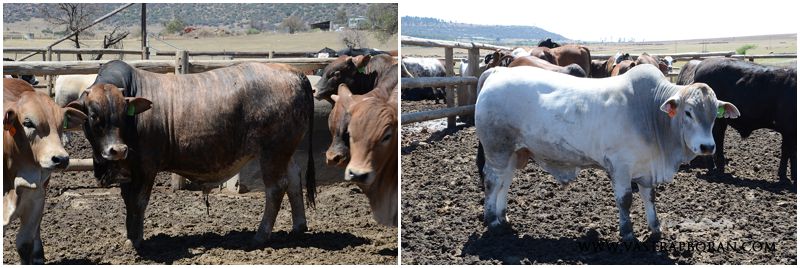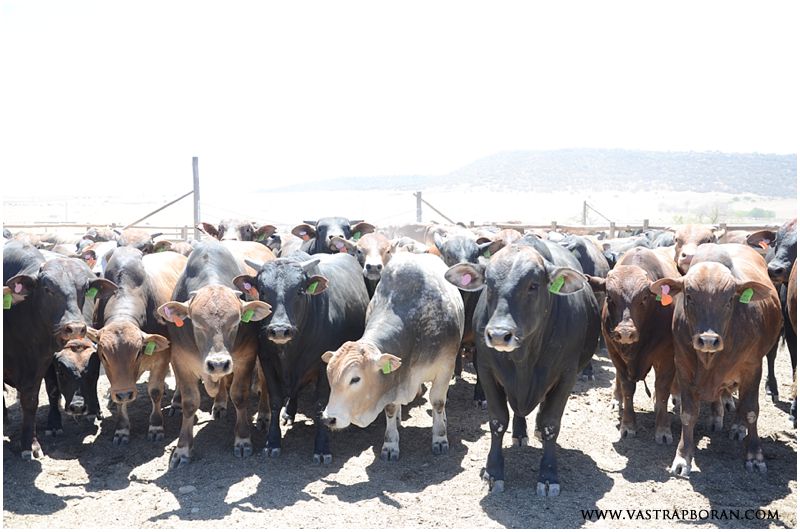I started Vastrap Boran in 2010, after farming commercially with Angus cattle for 10 years. My love affair with the Boran was very dramatic and almost instantaneous, but I did not take the decision to start a Boran stud lightly. As part of my research I visited several studs around the country, attended auctions and travelled to Kenya to learn first hand about the breed from the real experts and to witness them in their natural environment. In the end, I was very happy to conclude that the Boran are not just beautiful animals full of character, but they do also make business sense.
The following practical characterisics of the Boran finally won me over:
- The fact that they are an African breed, well adapted to our climate and particularly resistant to our local insect and tick borne deseases.
- The fact that they have an excellent ability to convert roughage into meat and can be successfully fattened off the veld makes them ideal to supply grassfed beef into an increasingly conscious consumer market.
- The fact that they are predomintely Bos Indicus and pure bred for 1 300 years makes them ideal to cross-breed (due to the hybrid vigour) with any of the other prominent breeds in South Africa. As the benefits of cross-breeding with Boran become more widely known there should be a natural demand for top quality bulls in commercial herds.
Before starting Vastrap Boran, my own commercial herd consisted of Angus cattle. As the biggest breed in the world, Angus have many benefits including that they are polled, have great fertility and are very sought after by feedlots. It seemed obvious to me to start a cross breeding programme with the Boran and Angus to try and marry their positive attributes while eliminating some of their weaknesses. This is not with the aim of creating a new composite breed, but rather a continuous cross-breeding programme that enables one to take advantage of the hybrid vigour resulting from the use of pure bred Boran and Angus bulls, which are so far apart genetically.
The design of my cross-breeding programme has been informed by the following factors that I have learned from experience over the years.
- Smaller animals tend to have better fertility than larger animals.
- Smaller animals consume less food since they eat a percentage of their body weight. In particular, the salt lick intake of the pure Boran is about a third of the Angus cows.
- African breeds have much lower input costs than their European counterparts and are also much less susceptible to insect- and tick-borne diseases leading to less fatalities.
- Most South African beef farmers produce weaners for the feedlot system. The feedlots control are huge percentage of the beef market, despite growing consumer demand for organic “grass-fed” beef.
- Feedlots tends to like calves from later maturing (larger) animals as well as those that are good at converting maize into beef.
With these factors in mind, my staring point is to have females in my commercial herd that are 75% Boran and 25% Angus. The advantage of this is that they will be hardier than the pure Angus and eliminate problems such as bad eyes and susceptibility to insect- and tick-borne diseases. They are also slightly smaller than the pure Angus, which allows one to have a higher stocking ratio, but they will also be slightly beefier/larger than the pure Boran. These cross-bred cows will enable my commercial herd to be larger, have less input costs and less general health problems and fatalities.
In July 2015, Vastrap Boran participated in a feedlot trial for crossbred Boran weaners with Sparta Beef (see “Crossbred Boran feedlot trial with Sparta“). We were given a very competitive price of R20.50/kg. Vastrap’s group of 108 animals averaged 223kg and included 20 females, thus giving us R4,577.65 (ex-VAT) per weaner.The results were great news for the Boran breed. In particular, the feed conversion rates (FCR), both during backgrounding and the feedlot phase were better than the feedlot average and the slaughter percentage was also excellent. Sparta management was very pleased and positive about the results of this particular group of Boran crossbred weaners.
I plan to use pure Angus bulls to breed on these F2 Boran females. This would produce a calf that is 62.5% Angus. Not only would this be a product that is a well suited to sell to feedlots, but due to both the hybrid vigour and the fact that Angus bulls used are larger than the cows, the calf should wean a large percentage of its mother’s body weight. This should result in a much higher kilogram of meat per hectare than in any pure bred system. The heifers that are retained from this particular cross-breeding programme will be strictly selected for size, to prevent the breeding stock getting too large and then cross-bred back to pure Boran bulls. Again, using pure Boran bulls will retain the hybrid vigour, producing a calf that has both a high weaning ratio relative to the mother weight and a calf acceptable for the feedlots.
I have been very impressed with the phenotype of the F2 Boran/Angus crosses. They are a stocky animals, short in the leg, but with loads of capacity. By next year, I will have enough F2 crosses to put back to the Angus bull for the first time and hopefully I will be able to report back favourably on the results of my continuous cross-breeding programme.













i like what i see, this is serious business
Are these on sale as well, I really like them. Please reply
Hi Johnny. Sorry it has taken so long to respond, but we were away for a little bit. I want to establish a herd of 75% boran cows that I cross breed back to Angus. At this stage I only have about 30 so I am hesitant to sell before I have sufficient numbers. I do have open F1 heifers for sale though. The F1 heifers I put back to Boran Bulls to breed my F2 heifers, so it is a long process.
Please feel free to schedule a visit to come and see what I am trying to create.
It wonderfully to see nice animal like this angus x boran is the best
This is a great achievement well done this animals are nicely there are look more good even to the pure breed
Thanks very much for getting in touch Nkosinathi. We love the pure breed too but these crosses really make sense for the commercial farmer.
Good food for the cattle man’s eye. Are they on veld, supplemented with minerals or they are on feeds as well? Hope my question makes sense. I just love Boran products. How do Boran Nguni crosses perform on feedlots? I have a pure Boran and Nguni cows and can’t wait to see their off springs.
Hi Marisa,
If you cross F2 Boran and an Angus bull there after do you intend continuing with angus or boran bull for this breed. Do you have Bulls from this cross already and how is doing.
Hi Johnny
Quentin’s view is that you must continue to use pure bred Bulls in a cross breeding programme to maximize hybrid vigour and to ensure that all the EBVs of the breed are official. With this in mind, I would use pure bred Angus (stud) on the F2 Boran which were created using pure bred Boran bulls. The male offspring from these crossings are all either sold to feedlots or grown out for slaughter. The best 30% of the females would be kept as breeding stock selecting for desirable traits in your area. These would then be crossed back to the opposite stud bull e.g. The Angus offspring from the F2 Boran would be crossed back to a Boran bull and so forth. Our strategy is not to create a new composite breed. Hope this helps, but please let us know if you have any further questions.
Hi Marisa
I am starting farmer with a head of 90 herd of cows/ready heifers excluding weaner tollies wich i send to the feedlots at +\- 200kg
I have a commercial and a pure breed Brangus bulls. They have been running with my cows ( 60% Brangus, 20 % brahman and 20% normal cross breeds). I want to get rid of the cross breed and get Boran cows and a Boran bull. My aim is to put the Brangus bulls in the Boran & Brahman cows and Boran bull with the Brangus cows/heifers. .
I want 10 Boran heifers as soon as I possibly get to replace the other stock. They can be commercial or pure ( liked your commercial stock in the pictures)
Is this a good start. I would like to get in touch with you.
Kind regrads
Luyanda
Hi Luyanda, thank you very much for your enquiry. We will respond to you via email and see if we can help! Regards, Marisa
Hi Marisa can you tell me you never try to crossbreed Brangus x Boran but this Angus x Boran are fantastic animal to see please feel free to let me aware on your first sale
Good morning this cross breeding information is an eye opener for a novice like me, the Borans are really and indeed impressive. I collected my bull DOC 15 44 “THEBE” Tonardo’s direct son and i am planning to use him on my boran cows and also nguni cows.
With the information I got for this article I an confident that crossing him with the Ngunis will not be a bad idea at all. I am looking forward to the Vastrap auction my eye will be on the f2 and f3’s, but over and above being there alone will be one of my Boran highlight experience since I will miss the Nationals. May the soon coming Lord keep blessing you daily as for being such a good stuwad to his creation.
Regards
Calvin N Korie
Thank you so much for your kind comments Calvin. Your bont bull catches my eye and looks very nice. We look forward to seeing you at Vastrap, you are most welcome!
Best regards,
Quentin and Marisa
good animals.. how much are they costing i want 4, i wanna start farming small small…where are you in the country situated
Hi Sbonelo
I currently have none for sale. My annual auction is in August next year where I will have at least 50 females for sale, mostly pregnant heifers. The starting price of SP registered pregnant heifers is about R20’000.
Hie this is really inspiring l would like to have this breed in my farm
Thank you for the complement.